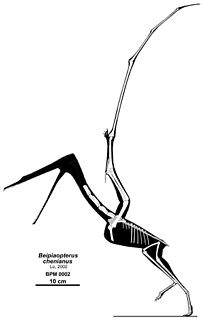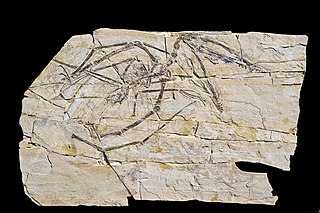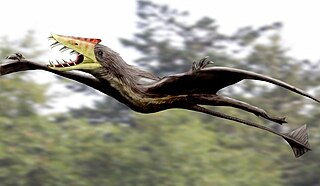
Pterosaurs were flying reptiles of the extinct clade or order Pterosauria. They existed during most of the Mesozoic: from the late Triassic to the end of the Cretaceous. Pterosaurs are the earliest vertebrates known to have evolved powered flight. Their wings were formed by a membrane of skin, muscle, and other tissues stretching from the ankles to a dramatically lengthened fourth finger.

Scansoriopterygidae is an extinct family of climbing and gliding maniraptoran dinosaurs. Scansoriopterygids are known from five well-preserved fossils, representing four species, unearthed in the Tiaojishan Formation fossil beds of Liaoning and Hebei, China.

The Rhamphorhynchoidea forms one of the two suborders of pterosaurs and represents an evolutionary grade of primitive members of flying reptiles. This suborder is paraphyletic in relation to the Pterodactyloidea, which arose from within the Rhamphorhynchoidea, not from a more distant common ancestor. Because it is not a completely natural grouping, Rhamphorhynchoidea is not used as a formal group in most scientific literature, though some pterosaur scientists continue to use it as an informal grouping in popular works, such as The Pterosaurs: From Deep Time by David Unwin, and in some formal studies. Rhamphorhynchoids were the first pterosaurs to have appeared, in the late Triassic Period. Unlike their descendants the pterodactyloids, most rhamphorhynchoids had teeth and long tails, and most species lacked a bony crest, though several are known to have crests formed from soft tissue like keratin. They were generally small, with wingspans rarely exceeding 2.5 meters, though one species alluded to by Alexander Stoyanow might be among the largest pterosaurs of all time with a wingspan of 10 meters, comparable to the largest azhdarchids. Nearly all had become extinct by the end of the Jurassic Period, though least one anurognathid genus, Dendrorhynchoides, persisted to the early Cretaceous. The family Wukongopteridae, which shows a mix of rhamphorhynchoid and pterodactyloid features, is known from the Daohugou Beds which are most commonly dated to the Jurassic, but a few studies give a Cretaceous date. Further more, remains of a non-pterodactyloid from the Candeleros Formation extend the presence of basal pterosaurs into the at least early Late Cretaceous.

Pterodactyloidea is one of the two traditional suborders of pterosaurs, and contains the most derived members of this group of flying reptiles. They appeared during the middle Jurassic Period, and differ from the basal rhamphorhynchoids by their short tails and long wing metacarpals. The most advanced forms also lack teeth, and by the late Cretaceous, all known pterodactyloids were toothless. Many species had well-developed crests on the skull, a form of display taken to extremes in giant-crested forms like Nyctosaurus and Tupandactylus. Pterodactyloids were the last surviving pterosaurs when the order became extinct at the end of the Cretaceous Period, together with the non-avian dinosaurs and most marine reptiles.

Beipiaopterus is a genus of ctenochasmatid pterosaur from the Early Cretaceous period of what is now the Yixian Formation of the China.
Eopteranodon is a genus of tapejarid pterosaur from the Aptian-age Lower Cretaceous Yixian Formation of Beipiao City, Liaoning, China. The genus was named in 2005 by paleontologists Lü Junchang and Zhang Xingliao. The type and only species is Eopteranodon lii.

Feilongus is an extinct genus of ctenochasmatid pterodactyloid pterosaur from the Barremian–Aptian-age Lower Cretaceous Yixian Formation of Beipiao, Liaoning, China.

Huaxiapterus is a genus of tapejarid pterodactyloid pterosaur from the Aptian-age Lower Cretaceous Jiufotang Formation of Chaoyang, Liaoning, China. It is the second genus of tapejarid from this formation, after Sinopterus. Three species are known, though they may not actually form a natural group with each other. It was first named by Lü Junchang and Yuan Chongxi.
Utahdactylus was a genus of extinct reptile from the Kimmeridgian-Tithonian-age Upper Jurassic Morrison Formation of Utah, United States. Based on DM 002/CEUM 32588, Czerkas and Mickelson (2002) identified it as a "rhamphorhynchoid" pterosaur. Bennett (2007) however, concluded that it has no diagnostic features of the Pterosauria, and cannot be positively identified beyond being an indeterminate diapsid.

Ningchengopterus is a genus of pterodactyloid pterosaur from the Early Cretaceous period. Its fossil remains were found in the Yixian Formation of what is now China.

The Tiaojishan Formation is a geological formation in Hebei and Liaoning, People's Republic of China, dating to the middle-late Jurassic period. It is known for its exceptionally preserved fossils, including those of plants, insects and vertebrates. It is made up mainly of pyroclastic rock interspersed with basic volcanic and sedimentary rocks. Previously, the Tiaojishan Formation was grouped together with the underlying Haifanggou Formation as a single "Lanqi Formation." The Tiaojishan Formation forms a key part of the Yanliao Biota assemblage.

Darwinopterus is a genus of pterosaur, discovered in China and named after biologist Charles Darwin. Between 30 and 40 fossil specimens have been identified, all collected from the Tiaojishan Formation, which dates to the middle Jurassic period, 160.89–160.25 Ma ago. The type species, D. modularis, was described in February 2010. D. modularis was the first known pterosaur to display features of both long-tailed (rhamphorhynchoid) and short-tailed (pterodactyloid) pterosaurs, and was described as a transitional fossil between the two groups. Two additional species, D. linglongtaensis and D. robustodens, were described from the same fossil beds in December 2010 and June 2011, respectively.

Sericipterus is an extinct genus of rhamphorhynchid pterosaur. It is known from the Late Jurassic Shishugou Formation in Xinjiang, China.

Monofenestrata is an unranked group of pterosaurs that includes the family Wukongopteridae and the suborder Pterodactyloidea.

Euctenochasmatia is an extinct group of pterodactyloid pterosaurs. It was named by David Unwin in 2003 as the group that contains the most recent common ancestor of Pterodactylus and Ctenochasma, and all their descendants.

Kunpengopterus is a genus of wukongopterid pterosaur from the middle-late Jurassic Tiaojishan Formation of northeastern China. The genus contains two species, the type species K. sinensis and K. antipollicatus.

Wukongopteridae is a group of basal pterosaurs, found in China and the UK. It contains eight species in five genera, all dated to the Middle to Late Jurassic period,
Daohugoupterus is a genus of pterosaur from the Middle to Late Jurassic Daohugou Beds of the Tiaojishan Formation in Inner Mongolia, China.

This timeline of pterosaur research is a chronologically ordered list of important fossil discoveries, controversies of interpretation, and taxonomic revisions of pterosaurs, the famed flying reptiles of the Mesozoic era. Although pterosaurs went extinct millions of years before humans evolved, humans have coexisted with pterosaur fossils for millennia. Before the development of paleontology as a formal science, these remains would have been interpreted through a mythological lens. Myths about thunderbirds told by the Native Americans of the modern Western United States may have been influenced by observations of Pteranodon fossils. These thunderbirds were said to have warred with water monsters, which agrees well with the co-occurrence of Pteranodon and the ancient marine reptiles of the seaway over which it flew.

Douzhanopterus is an extinct genus of monofenestratan pterosaur from the Late Jurassic of Liaoning, China. It contains a single species, D. zhengi, named by Wang et al. in 2017. In many respects, it represents a transitional form between basal pterosaurs and the more specialized pterodactyloids; for instance, its tail is intermediate in length, still being about twice the length of the femur but relatively shorter compared to that of the more basal Wukongopteridae. Other intermediate traits include the relative lengths of the neck vertebrae and the retention of two, albeit reduced, phalanx bones in the fifth digit of the foot. Phylogenetically, Douzhanopterus is nested between the wukongopterids and a juvenile pterosaur specimen from Germany known as the "Painten pro-pterodactyloid", which is similar to Douzhanopterus in many respects but approaches pterodactyloids more closely elsewhere.




























